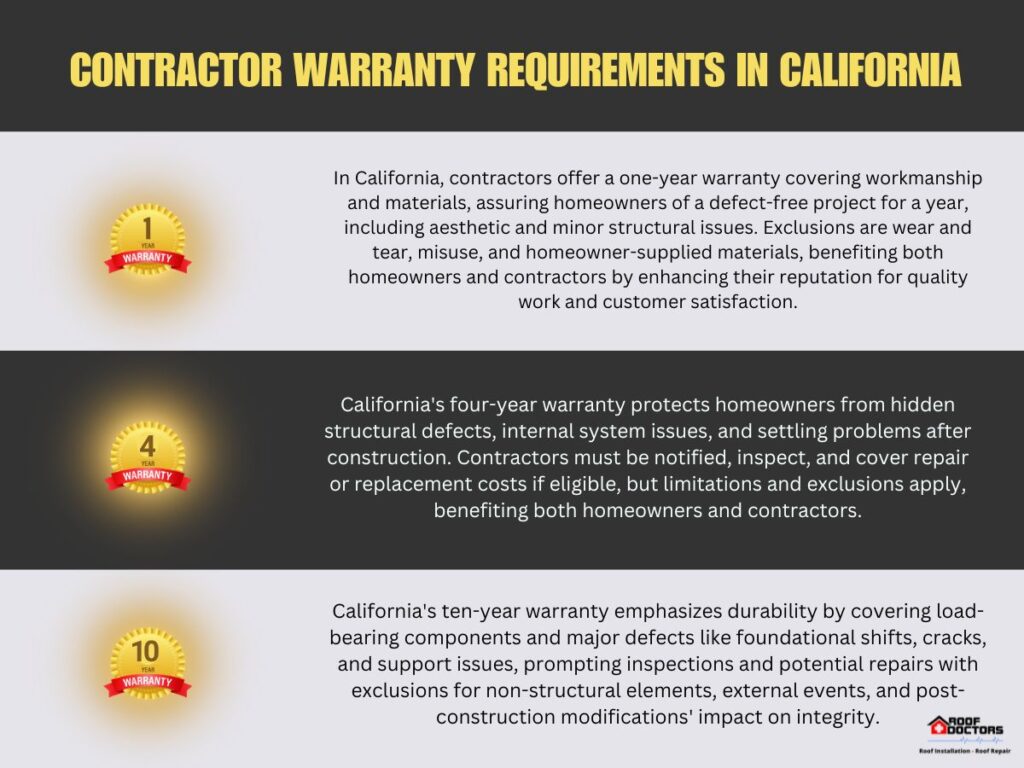In the vast landscape of California’s construction industry, warranties stand as silent sentinels, safeguarding both homeowners and contractors. These warranties, spanning short to long-term commitments, reflect the quality of work and trust between the contractor and client. What are the contractor warranty requirements in California?
California mandates that all contractors must maintain an active contractor license bond, which they must set at $25,000. This bond safeguards consumers from financial harm due to contractor non-compliance with licensing laws.
As we delve into the intricacies of California’s contractor warranty requirements, specifically the one-year, four-year, and ten-year warranties, we’ll uncover the protections they offer, the obligations they entail, and their significance in ensuring lasting construction quality.
Join us as we navigate the complexities of these warranties, providing clarity for homeowners and contractors alike.

- One-Year Warranty
Contractors in California provide a fundamental protection known as the one-year warranty. This warranty guarantees that the work they perform meets specific standards and remains free from defects for a year after completion. This warranty is a testament to the contractor’s confidence in the quality of their work and serves as a safety net for consumers.
Here’s a detailed look at the one-year warranty:
Scope of the Warranty
The one-year warranty typically encompasses both workmanship and materials. It ensures one year of defect-free work and materials from completion.
What’s Covered
- Fit and Finish: This includes the final touches on a project, ensuring that everything looks as it should. It covers paint jobs, trim work, finishes, and other aesthetic aspects of a project.
- Cosmetic Issues: These issues are more about appearance and don’t impact functionality or safety. Examples include uneven paint, misaligned tiles, or gaps in caulking.
- Minor Structural Issues: One can address these problems without undertaking major renovations or overhauls. For instance, a door that doesn’t close properly or a window that’s slightly misaligned.
Contractor Obligations
If a defect or issue arises within the one-year period, the contractor has specific obligations:
- Notification: The homeowner must first notify the contractor of the defect.
- Inspection: Give the contractor an opportunity to inspect the reported defect to ascertain its cause and extent.
- Repair or Replacement: If the defect falls under the warranty, the contractor must fix it at their expense.
Limitations and Exclusions
While the one-year warranty is comprehensive, there are certain limitations:
- Ordinary Wear and Tear: The warranty doesn’t cover issues arising from the regular use of the installed item or completed work.
- Misuse or Neglect: Defects resulting from the homeowner’s misuse of an item or neglect of necessary maintenance might not receive coverage.
- Homeowner-Supplied Materials: Materials provided by the homeowner for the project, which subsequently exhibits defects, might not fall under the contractor’s warranty coverage.
Benefits for Both Parties
The one-year warranty provides homeowners with peace of mind, assuring them that they have protection against potential defects. For contractors, offering a one-year warranty can boost their reputation, showcasing their commitment to quality and customer satisfaction.
- Four-Year Warranty
In California, the four-year warranty provides an extended layer of protection for homeowners against latent defects that may not be immediately apparent post-construction. This warranty underscores the importance of long-term quality and durability in construction projects.
Here’s a comprehensive look at the four-year warranty:
Scope of the Warranty
The four-year warranty specifically targets latent defects. These are defects that aren’t immediately obvious or discoverable upon a reasonable inspection shortly after the completion of the work.
What’s Covered
- Hidden Structural Defects: These are issues that might be concealed within walls, floors, or ceilings and may not be immediately evident. For instance, internal support beams that might be compromised or improperly installed insulation.
- Internal Systems: This includes problems with plumbing, electrical, or HVAC systems that may not manifest immediately but become apparent over time.
- Settling Issues: Some issues, like those resulting from the settling of a building or house, might only become noticeable after a period of time.
Contractor Obligations
For defects that surface within the four-year window:
- Notification: Homeowners should notify the contractor about the defect in a timely manner.
- Inspection: Once notified, the contractor has the right and obligation to inspect the defect to determine its cause and the best course of action.
- Repair or Replacement: If the defect is verified and falls under the warranty’s purview, the contractor must either repair or replace the defective work, bearing the associated costs.
Limitations and Exclusions
The four-year warranty, while extensive, does have its limitations:
- Reasonably Discoverable Defects: If a defect should have been reasonably discovered within the initial one-year warranty period, it might not be covered under the four-year warranty.
- External Factors: Defects or damages resulting from external events, such as natural disasters, are typically not covered.
- Alterations and Modifications: If homeowners make alterations or modifications post-construction, and these changes lead to defects, such issues might be excluded from the warranty.
Benefits for Both Parties
For homeowners, the four-year warranty offers extended assurance, allowing them to feel secure in the longevity of their construction project. For contractors, this warranty demonstrates a commitment to long-term quality, which can enhance their reputation and foster trust with clients.
3. Ten-Year Warranty
The ten-year warranty stands as a testament to the long-term durability and structural integrity of construction projects in California. It’s the most extended warranty period provided by contractors, emphasizing the importance of safety and stability in construction endeavors.
Let’s delve into the specifics of the ten-year warranty:
Scope of the Warranty
The ten-year warranty primarily focuses on “load-bearing” components of a construction project. It ensures that the fundamental structural elements of a building remain sound and safe over an extended period.
What’s Covered
- Major Structural Defects: These are significant issues that can compromise the stability or safety of a building. Examples include foundational shifts, major cracks in load-bearing walls, or significant roof frame defects.
- Foundation Issues: Problems related to the settling, shifting, or cracking of the foundation fall under this warranty. This ensures that the base of the structure remains solid and intact.
- Primary Support Elements: This encompasses issues with main support beams, load-bearing walls, and other critical structural components that are essential for the building’s integrity.
Contractor Obligations
When defects arise within the ten-year period:
- Notification: The homeowner must promptly notify the contractor of any perceived structural defect.
- Inspection: The contractor is obligated to inspect the reported defect to ascertain its nature and severity.
- Repair or Reconstruction: Given the gravity of defects covered under this warranty, contractors might need to undertake significant repairs or full-scale reconstruction. This could involve collaboration with structural engineers or other specialists to ensure the building’s safety.
Limitations and Exclusions
Despite its comprehensive nature, the ten-year warranty has certain limitations:
- Non-Structural Elements: Elements that don’t directly impact the building’s structural integrity, even if they have long-term implications, might not be covered under this warranty.
- External Causes: Issues arising from external events, such as earthquakes or floods, are typically excluded.
- Post-Construction Modifications: If a homeowner makes significant modifications after the initial construction, and these lead to structural issues, such problems might be excluded from the warranty.
Benefits for Both Parties
For homeowners, the ten-year warranty offers a decade of assurance regarding the structural integrity of their property. Knowing their home or building is built to last is a significant confidence booster.
For contractors, providing a ten-year warranty showcases their commitment to excellence, quality, and the long-term safety of their projects.
There You Have It!
California’s contractor warranty requirements, spanning from one to ten years, underscore a commitment to excellence and trust in the construction realm. These warranties protect homeowners from potential defects and elevate the standards by which contractors operate.
Understanding and valuing these warranty durations ensures a harmonious relationship built on quality, accountability, and mutual respect. Ultimately, it’s about more than just buildings and homes; it’s about constructing a legacy of reliability and integrity for generations to come.


